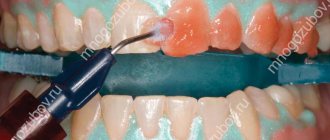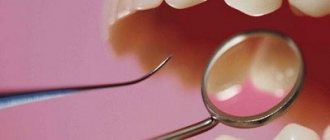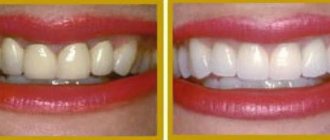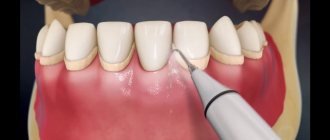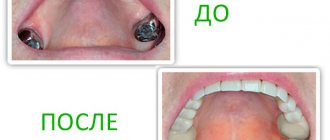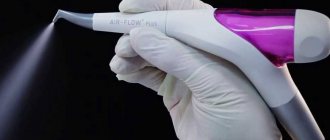A tooth that has darkened after nerve removal is a very common problem. And the problem is quite serious, especially from the aesthetic side. More recently, this problem was solved in a radical way. The tooth was to be ground down, and a crown was put on top of it. Today this problem has been solved! In dentistry, they began to use the so-called endobleaching of teeth. Endo-bleaching is an excellent solution for whitening teeth that have become dark due to the removal of a nerve from a tooth. The procedure is simple. First, the cause of the tooth discoloration is identified. An x-ray is taken and the quality of the early canal treatment is assessed. Then the old filling is removed from the back wall of the tooth and the affected tissue is eliminated by secondary caries. The mouths of the root canals are thoroughly cleaned of the coloring paste, then isolated with a special gasket. A whitening gel is added to the freed space, after which the tooth is closed with a temporary filling. A few days later, the person goes to the dentist and he evaluates the result. If the color remains the same or is not satisfactory, the procedure is repeated - a new portion of whitening gel is installed. In practice, the procedure is repeated several times to achieve the desired effect. After achieving the desired color, the temporary filling is replaced with a permanent one.
What is endocanal teeth whitening?
Endo-bleaching is a method of intracoronal teeth whitening, characterized by placing a bleaching agent into a dental cavity freed from pulp. The procedure involves a number of manipulations, which include:
- determining the cause of darkening of teeth;
- conducting an X-ray examination and subsequent assessment of the quality of canal treatment;
- removing a previously installed seal;
- removal of stained areas and tissues affected by secondary caries;
- applying an insulating glass ionomer cement gasket to the root canal orifices;
- introducing a whitening gel into the tooth cavity and blocking it with a temporary filling;
- assessment of whitening results 14 days after the end of the dental procedure;
- repeated introduction of a bleaching agent into the dental cavity (if indicated);
- complete tooth restoration.
Preparation for the procedure
The technique can be used exclusively on pulpless units, that is, the canals must be cleaned and treated, and darkened pulp should not remain inside the crown.
If the roots were filled long ago, you have to clean them of material and re-treat them. In this case, special protapers are used, which are ultra-flexible nickel-titanium files. They are inserted into the sealed canal in order to extract the mass located in it.
The doctor then disinfects the walls using a chelating agent and sodium hypochlorite . At the end of the preparatory stage, the treated canal is obturated, that is, its lumen is closed.
Indications for teeth whitening
The main indications for performing the teeth whitening procedure are:
- darkening of the tooth that cannot be corrected externally;
- tooth injury, accompanied by hemorrhage into the pulp chamber;
- death of the pulp due to periodontitis or pulpitis and subsequent darkening of the “dead” tooth;
- the use of coloring pastes when filling dental canals;
- a change in the shade of dentin, caused by the penetration of dyes through microscopic cracks in the enamel layer.
Advantages of the technique
In-canal whitening remains popular, despite the emergence of more progressive programs, because:
- is affordable;
- does not cause pain;
- allows you to work with units located in any area of the oral cavity;
- provides excellent aesthetic results in a short time;
- copes even with complex defects.
Very often, endodontic bleaching helps when other methods fail. The only thing is that the treated tooth does not always remain white. About two to three years after the procedure, it begins to darken again. Then the person again has to turn to an aesthetic dentist for help.
Contraindications to endocanal teeth whitening
Reasons for refusing teeth whitening may include:
- age up to 16 years;
- period of pregnancy or lactation;
- allergy to contact with hydrogen peroxide;
- inflammatory lesions of the periodontium (periodontal disease, periodontitis)
- increased sensitivity of teeth;
- excessive abrasion of tooth enamel;
- the presence of many carious defects in the patient’s oral cavity;
- thyroid diseases;
- the presence of cracks on the surface of the enamel layer;
- diabetes;
- change in the shade of teeth that were previously restored using photopolymers (in such a situation, the endobleaching procedure does not give the expected result).
Endodontic bleaching technique
Before putting a whitening compound inside, the doctor needs to understand what led to the darkening of the enamel. If the cause of the problem is not established, the likelihood of relapse will remain very high. During the diagnosis, the specialist examines the condition of the roots, looks at the results of x-ray diagnostics, and draws up a detailed anamnesis.
The next preparatory stage is the formation of an expanded cavity for laying the gel inside . If necessary, the pulp area is first cleaned and low-quality fillings are removed.
The gel is poured into the dental canal using a syringe applicator. Neighboring teeth that do not need whitening are isolated. It is important that the brightening solution does not get on their surface. When the gel is in the designated place, it is covered with a thick cotton ball and fixed with a cement temporary filling.
The dentist always decides how many days the patient has to wait for a second appointment on an individual basis. It all depends on:
- unit state;
- degree of destruction of the coronal part;
- the presence of concomitant dental diseases;
- expected effect.
It is important that the client comes for a follow-up appointment exactly on the day indicated by the doctor. Some people find that it is better to take longer with the bleaching medicine, since they want to lighten one unit by a large number of tones in one procedure. Doctors never tire of repeating: you should never do this.
The solution inside the channel is quite aggressive. If you overexpose it, the already weakened walls of the tooth after depulpation will become even more fragile. Negative reactions will begin to occur inside the dental cavity. This may result in the loss of a unit. Then only prosthetics will help.
During the re-examination, the doctor checks whether the expected result is obtained. If not, remove the drug, treat the channels and use a second portion of the gel. The maximum number of such bookmarks should not exceed four.
When the expected effect is achieved, the canals are washed, sealed and a permanent filling is installed. From this moment on, the patient can freely use his renewed tooth and enjoy a beautiful smile.
Side effects from the teeth whitening procedure
Manufacturers of gels for endocanal teeth whitening do not hide the fact that the whitening products contain components that have an active destructive effect on the proteins of any dyes contained in filling materials. Meanwhile, even the most modern whitening compositions do not allow achieving the desired results after the first visit to the dentist. As a rule, darkened teeth acquire the required shade only after several sessions of the procedure.
Another disadvantage of intracanal bleaching is the gradual weakening of the strength of the molar, which significantly increases the risk of crown fracture. This is explained by the fact that regenerative processes do not occur in the pulpless tooth, which would allow the elimination of post-procedural defects. For this reason, the endobleaching procedure on one tooth is repeated no more than four times.
Dentists remind you that under no circumstances is it allowed to whiten teeth darkened after carious treatment or pulpitis with pastes, dental strips or gels intended for use at home. The listed means not only do not help remove the dye from the tooth cavity and achieve the desired result, but also have a negative effect on the enamel layer, significantly weakening its protective properties.
When to use
Teeth take on an unsightly gray tint when their internal structure becomes damaged. Most often this occurs due to the destruction of pulp tissue, progressive chronic pulpitis, and periodontitis. Then the metabolic processes required for normal nutrition of the crown and roots become impossible. The enamel becomes thinner and cracks. It does not receive enough minerals and darkens.
Among the reasons for changes in the natural color of a smile that can be corrected by intracanal whitening are:
- Mechanical injuries of the jaw. Very often, patients whose problem with dark teeth appeared in childhood come to see a dentist. People put off making a decision, but at some point they still make an appointment with the doctor. Whitening the crown by targeting the canals is an excellent option.
- Age-related changes. With age, tissues are less well supplied with blood. The risk of smile changes is especially high if depulpation has been performed.
- Increased abrasion of enamel. This is a pathological condition that needs to be treated. As it develops, microcracks form on the outer surface. This is what leads to a change in shade.
- Depulpation performed for medical reasons. After this procedure, proper nutrition of the dental tissues becomes impossible; the nerves are removed. In the absence of a neurovascular bundle, the unit darkens.
- Installation of a filling containing silver impurities. Fortunately, today dentists no longer use such materials. But there are still people who have such fillings. They must be replaced after performing intracanal bleaching.
- Use of resorcinol-formalin mixture in canal treatment. In this case, the coronal part becomes pink. It looks quite strange.
- Incompetent endodontic therapy. In case of incomplete removal of the damaged nerve, poor-quality cleaning of the canals, or leaving a fragment of the instrument inside the root, undesirable consequences arise.
All of the above situations are a reason to consult a dentist and perform intracanal bleaching.
Why do teeth darken and when to whiten them?
Teeth can darken from the inside for several reasons. Firstly, after filling, dentin may become stained from contact with certain types of fillings. Thus, the resorcinol-formalin composition forms a pink color, silver - black and gray. In addition, when the pulp dies (as a result of pulpitis or periodontitis), darkening of the tooth also occurs, and is preceded by a loss of shine. Dyes contained in food products, as well as in tobacco smoke, penetrate into the microcracks of the teeth and contribute to darkening of varying degrees, depending on the size of the cracks.
Based on the above, the internal teeth whitening procedure is indicated in the following situations:
- when the hard tissues of the tooth have darkened due to filling with coloring compounds;
- if external bleaching was used - and did not give the desired result.
Advantages and disadvantages
There are several positive aspects that make in-canal whitening popular:
- High efficiency.
- Reasonable price.
- No pain or discomfort.
- Does not affect neighboring units.
One of the disadvantages is the fact that the tooth becomes more “fragile” and vulnerable to external factors. In 10% of cases, there is no visible result. More precisely, the tooth is lightened, but the desired effect cannot be achieved.
Clinical researches
Clinical experiments with the use of the Asepta series of products, conducted at the Ryazan State Medical University named after Academician I.P. Pavlova of the Ministry of Health and Social Development of the Russian Federation (GBOU VPO RyazSMU Ministry of Health and Social Development of Russia) have proven that the use of Asepta line products results in a decrease in complaints of discomfort, but bleeding persists when brushing teeth.
On examination, hyperemia and bleeding of the gingival papillae are noted. On the 7th day, complaints of gum bleeding persisted in 4 patients. Upon examination, a decrease in hyperemia and swelling of the gums was noted, but bleeding persisted upon probing. On day 14, 2 patients continued to complain of bleeding gums when brushing their teeth; upon examination, a significant decrease in hyperemia and swelling of the gums was noted. After the final application of the gel with propolis, normalization of clinical manifestations was revealed, which is manifested by the absence of bleeding during brushing and probing.
Sources:
- Clinical experience in using the Asepta series of products Fuchs Elena Ivanovna Assistant of the Department of Therapeutic and Pediatric Dentistry State Budgetary Educational Institution of Higher Professional Education Ryazan State Medical University named after Academician I.P. Pavlova of the Ministry of Health and Social Development of the Russian Federation (GBOU VPO RyazSMU Ministry of Health and Social Development of Russia)
- Report on determining/confirming the preventive properties of toothpaste “ASEPTA PLUS” GENTLE WHITENING” Author: doctor-researcher A.A. Leontyev, head Department of Preventive Dentistry, Doctor of Medical Sciences, Professor S.B. Ulitovsky First St. Petersburg State Medical University named after. acad. I.P. Pavlova, Department of Preventive Dentistry
- Clinical and laboratory assessment of the influence of domestic therapeutic and prophylactic toothpaste based on plant extracts on the condition of the oral cavity in patients with simple marginal gingivitis. Doctor of Medical Sciences, Professor Elovikova T.M.1, Candidate of Chemical Sciences, Associate Professor Ermishina E.Yu. 2, Doctor of Technical Sciences Associate Professor Belokonova N.A. 2 Department of Therapeutic Dentistry USMU1, Department of General Chemistry USMU2
- Report on the determination/confirmation of the preventive properties of personal oral hygiene products “ASEPTA PLUS” Remineralization doctor-researcher A.A. Leontyev, head Department of Preventive Dentistry, Doctor of Medical Sciences, Professor S.B. Ulitovsky First St. Petersburg State Medical University named after. acad. I.P. Pavlova, Department of Preventive Dentistry
What to choose?
The lightening procedure is carried out at will. Often the frontal incisors and canines are lightened, because they are visible. If their shade differs by one or two shades, it is already noticeable to others. Lightening is a serious manipulation, as it involves chemical exposure. Therefore, it must be carried out by a dentist so that the result is long-lasting and the shade does not differ from the color of healthy teeth. To prevent the crowns from being destroyed or crumbling, the manipulation must be carried out by a specialist. Only a qualified dentist will protect the gum tissue from irritation by protecting it with special means. Also, the doctor will choose a safe method of action.
- An alternative to lightening from the inside are inlays and crowns, if the organ is not severely damaged. This solves the problem of color, as well as strengthening the unit, and reduces the risk of further destruction.
- The technology of restoration with veneers is suitable for patients with crooked, spotted teeth, the crown layer of which is slightly destroyed.
- Lightening from the inside is necessary when dentin darkens when other methods do not give results.
To avoid unpleasant situations, you should carefully care for your oral cavity, regularly visit the dental office, carry out timely sanitation and treatment of carious cavities. Taking care of the oral cavity is the key to the health of the whole body.
Causes of darkening
Each chewing unit consists of roots and a crown. Below the crown is the pulp chamber containing the pulp called the nerve. Blood vessels and nerve endings pass through the pulp, supplying the tooth with nutrients.
A dead tooth is one from which the pulp has been removed.
After removal of the nerve, strong enamel continues to perform its functions and remains in the gum. But the necessary substances do not reach it, the dentin dries out, and the tissue begins to darken. Another reason for discoloration is damage to the blood vessels when the nerve is removed. Blood quickly stains dentin, and it is useless to bleach the surface using traditional methods.
